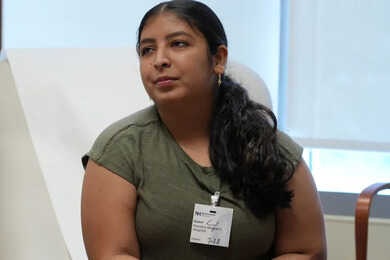- Health Conditions A-Z
- Health & Wellness
- Nutrition
- Fitness
- Health News
- Ayurveda
- Videos
- Medicine A-Z
- Parenting
- Web Stories
Man Dies From Brain Damage After Drinking Just One Sip Of Rotten Coconut Water

Image Credits: Canva
What was meant to be a refreshing drink from a tropical delight became a medical disaster for a 69-year-old man in Aarhus, Denmark. Following the ingestion of only a small quantity of coconut water from a rotten coconut, the man developed sudden onset of severe symptoms that resulted in his death within 26 hours of admission. This startling case, reported in a recent scientific study and widely debated in the international medical community, highlights a lesser publicized but potentially deadly foodborne hazard- fungal neurotoxins.
This is not merely an isolated event—this is a wake-up call for consumers and food safety agencies around the world, especially as pre-packaged and fresh fruits and vegetables become increasingly popular in home kitchens as well as tourist destinations.
The Danish man, whose name has not been released, bought a pre-hydrated coconut about a month ago. Left at room temperature on his kitchen table, the coconut had obviously spoiled. When he drank the water through a straw, the man quickly detected a bad flavor and discarded the coconut after examining its slimy, rotten center. Sadly, that one sip was enough.
Within a span of three hours, the man came down with a high fever, profuse sweating, and vomiting. Emergency workers encountered him pale, confused, and unbalanced—symptoms indicative of acute neurological distress. He was taken to the hospital, where an MRI confirmed massive brain swelling. Despite intensive treatment and a diagnosis of metabolic encephalopathy (a state in which the brain is impaired by chemical imbalances), his condition quickly deteriorated. He was pronounced brain dead just more than a day later.
Ssuspicions fell initially on the known food toxin bongkrekic acid, but continued study and tests revealed a sinister culprit: a fungus, Arthrinium saccharicola, in the man's windpipe and also in the rotting coconut.
This is a rare fungus, which produces 3-nitropropionic acid (3-NPA), an agent that is known to be highly neurotoxic. The toxin has the effect of breaking down the production of cellular energy in the brain, causing rapid swelling, loss of brain function, and death in extreme conditions. Importantly, there is no antidote for 3-NPA; supportive treatment is only offered, and this is centered on symptom management like encephalitis, seizures, and metabolic imbalance.
What's even more worrisome is that it wasn't much coconut water that triggered this effect. It only needed an infinitesimal dose of the toxin from the fungus to be devastatingly detrimental to the brain.
The toxicity of 3-NPA is not new. Chinese and some African medical journals have reported poisonings since the early 1990s. In all such cases, moldy sugarcane was the source. Patients experienced gastrointestinal upset—vomiting and diarrhea—followed by neurological symptoms such as confusion, seizures, and coma. In some cases, the illness was fatal.
This Danish case is the first reported instance linking Arthrinium saccharicola to spoiled coconut water, and as such, it is a highly unusual and alarming case of how this toxin can appear from various food sources based on storage and environmental conditions.
Why Refrigeration Isn't Optional for Food Safety?
Experts now want consumers to rethink how they store coconuts and other perishable fruits. Dr. Samuel Choudhury, a Singapore-based medical influencer with more than 300,000 followers, stressed in an Instagram post the need to keep pre-shaved coconuts refrigerated. "Always keep these coconuts in the fridge since they are already partially peeled," he explained. "Only whole coconuts should be kept at room temperature."
The outer husk of intact coconut serves as a natural covering, slowing down spoilage. But when shaved or pierced, the exposed white interior becomes very vulnerable to microbial and fungal invasion. Left on the kitchen counter, these coconuts will ferment, spoil, or acquire toxic fungi—without any signs of mold or warning until too late.
Significance of Consumer Awareness
Although coconut water is touted for its hydrating qualities and is a common staple in most tropical diets, this particular instance points to the potential dangers of mishandled or stored improperly natural drinks. With the worldwide trend towards fresh, unprocessed foods, education for consumers becomes increasingly vital.
Health officials all over the world are taking heed. In the wake of the incident, European food safety networks have reaffirmed requiring explicit labeling of fresh coconut products, such as expiration dates and storage in refrigerators.
Even a sip of improperly stored coconut water can prove deadly due to rare fungal toxins. Always refrigerate partially peeled or pre-shaved coconuts, consume them within a few days, and discard anything that tastes or smells off. When in doubt—throw it out.
What This Teen Ignored As A Minor Symptom Ended Up Being A Rare Vaginal Cancer Usually Found in Older Women

Credits: Canva
Liliana “Lili” Castaneda thought she was experiencing her first period at the age of 14, right in the middle of the COVID-19 pandemic. Initially, she was excited, but her monthly bleeding soon turned into daily bleeding. The flow became so heavy that she would soak through pads in just 15 minutes and feel dizzy when standing up. When she first visited her doctor, she was told it was likely stress related to the pandemic.
Teen’s Heavy Bleeding Dismissed As Pandemic Stress
Lili, who is now 19, sensed something more serious was going on. A month before her 15th birthday, after insisting on further evaluation, she was diagnosed with a rare vaginal cancer known as clear cell carcinoma, a type of cancer usually seen in postmenopausal women, according to her physician, Dr. Dario Roque.Dario Roque, MD, a gynecologic oncologist at the Lurie Cancer Center at Northwestern Medicine, said in a statement that in his 15 years of practice, Liliana was the youngest patient he had ever seen with clear cell carcinoma, a disease he typically treats in women in their sixties.
ALSO READ: Ozempic Pill vs Injection: New Study Finds Oral Tablets May Be More Effective
Her radiation oncologist, Jonathan Strauss, MD, explained that the tumour was roughly the size of a golf ball when it was found. “It was too large to remove surgically at the time of diagnosis, so we relied on both external and internal radiation to shrink it. Eliminating the tumour required extensive radiation along with chemotherapy,” he said.
What Is Clear Cell Carcinoma?
Clear cell carcinoma is a type of cancer where the affected cells appear pale or “clear” under a microscope, often due to glycogen and lipid content. While the most common form, clear cell renal cell carcinoma (ccRCC), affects the kidneys in adults, clear cell carcinoma can also develop in other parts of the body, including female reproductive organs.Symptoms may include pain, blood in the urine, unexplained weight loss, or a lump in the affected area, though sometimes the cancer is discovered incidentally during imaging for unrelated issues. Diagnosis is typically confirmed with imaging scans and a biopsy. The National Cancer Institute describes it as “a rare type of cancer in which the cells look clear when viewed under a microscope.”
Clear Cell Carcinoma Symptoms
Early stages of clear cell renal cell carcinoma often produce no noticeable signs. As the disease progresses, symptoms may include:- Blood in the urine (hematuria)
- Persistent fatigue
- Fever
- A lump on the affected kidney
- Pain in the side or flank
- Unexplained weight loss
What Causes Clear Cell Renal Cell Carcinoma?Most kidney cancers, including ccRCC, develop without a clear cause. Certain factors, however, may increase risk, such as:
- Tobacco use, including smoking and vaping
- Being overweight or having a BMI over 25
- High blood pressure
- Chronic kidney disease requiring dialysis
- Exposure to workplace toxins like trichloroethylene
- Long-term use of pain relievers such as acetaminophen.
Ozempic Pill vs Injection: New Study Finds Oral Tablets May Be More Effective

Credits: Canva
With obesity now affecting 41.9% of adults in the United States, according to the Centers for Disease Control and Prevention (CDC), medications like semaglutide have gained enormous attention. Semaglutide belongs to a class of drugs called GLP-1 receptor agonists, which help the body release more insulin, lower blood sugar levels, and send signals to the brain to reduce appetite.
The U.S. Food and Drug Administration (FDA) has approved several versions of semaglutide for diabetes and weight management. Wegovy and Ozempic are available as injections, while Rybelsus comes in tablet form. A new study now suggests that a daily pill containing semaglutide could be even more effective for weight loss than the injectable versions.
Ozempic Pills For Weight Loss More Effective Than Injections?
A major clinical trial has found that a daily semaglutide pill helped adults with overweight or obesity lose far more weight compared to a placebo over a 64-week period. The findings, published in The New England Journal of Medicine, suggest that an oral version of Ozempic could soon join the list of FDA-approved options for weight management.Currently, semaglutide injections such as Ozempic and Wegovy are taken weekly, with doses of up to 2.4 milligrams administered under the skin of the stomach, thigh, or arm. While effective, many patients avoid them because of the discomfort of injections. The trial results, part of the OASIS-4 phase 3 study, highlight that a pill form could be a needle-free, more convenient alternative if approved by regulators.
ALSO READ: Ozempic May Not Be Helpful If You Continue Emotional Eating: Study
Researchers also noted other advantages. Pills don’t require refrigeration, unlike injections, which could make treatment more accessible in places where storage and transport of injectable drugs are difficult.
How Ozempic Works
Ozempic helps regulate blood sugar in three main ways: it prompts the pancreas to release more insulin after meals, prevents the liver from releasing stored sugar, and slows down digestion so food moves more gradually through the body.Ozempic vs. WegovyWhile both Ozempic and Wegovy contain semaglutide, there are key differences:
- Dosage and delivery: Wegovy is usually prescribed at a slightly higher dose than Ozempic. Both are available as injection pens, but Ozempic pens contain multiple doses, while Wegovy pens are single-use.
- Conditions treated: Wegovy is FDA-approved specifically for long-term weight management, whether or not a person has diabetes. Ozempic, on the other hand, is officially approved for type 2 diabetes, though doctors often prescribe it “off-label” for weight loss.
Ozempic Pill vs. Injection for Weight Loss: Which Is Better?
The new findings suggest that the oral pill form of semaglutide may be more effective than injections for weight loss. Patients take the pill once daily, typically in the morning at least 30 minutes before eating or taking other medicines, and only with a small amount of water.Still, there are important points to note. The FDA has approved Wegovy for weight loss in both diabetic and non-diabetic patients, but neither Ozempic nor Rybelsus (the current oral version of semaglutide) has official FDA clearance for this purpose. These drugs are only approved for type 2 diabetes, though doctors can prescribe them off-label for weight management if they see fit.
'Nightmare Bacteria' Cases Increase By Nearly 70%, CDC Report Reveals: What Is It And How To Recognize It's First Signs

(Credit-Canva)
A recent report revealed that the number of infections from drug-resistant "nightmare bacteria" has jumped significantly in the US. The numbers of cases increased by almost 70% from 2019 to 2023. This information comes from a new report by scientists at the Centers for Disease Control and Prevention (CDC), US. These bacteria are becoming a major concern because they are harder to treat, making common infections potentially dangerous.
What Is Nightmare Bacteria?
According to the Association for Professionals in Infection Control and Epidemiology (APIC), "nightmare bacteria" are extremely dangerous germs because they have become resistant to almost all antibiotics, making them nearly impossible to treat. Some examples include VRSA (Vancomycin-resistant Staphylococcus aureus), Candida auris, and CRE (Carbapenem-resistant Enterobacterales). The CDC also estimates that more than 23,000 Americans die each year from infections that are resistant to antibiotics.
What Makes This Bacteria Immune To Drugs?
A big reason for this increase is a specific type of bacteria that has the NDM (New Delhi metallo beta lactamase) gene. This gene makes the bacteria resistant to most antibiotics. According to the CDC researchers, only two antibiotics can fight these infections, and they are expensive and have to be given through an IV (intravenous drip).
These bacteria with the NDM gene were once very rare in the U.S., usually found only in people who had received medical care in other countries. However, the number of U.S. cases has increased more than five times in recent years. Experts called this rise a "grave danger" and "very worrisome."
The CDC scientists also warned that many people might be carrying these drug-resistant bacteria without even knowing it, which could lead to them spreading easily in communities. This means that infections that have always been simple to treat, like a urinary tract infection (UTI), could become a long-term problem.
How Many Cases of Nightmare Bacteria Have Been Reported?
The researchers gathered data from 29 states that have the necessary systems to test for and report these drug-resistant bacteria. In 2023, they counted 4,341 cases of carbapenem-resistant infections in those states. Out of these, 1,831 were caused by the NDM-type bacteria. The report didn't mention how many people died from these infections.
The rate of carbapenem-resistant infections went from just under 2 per 100,000 people in 2019 to more than 3 per 100,000 in 2023, which is a 69% increase. Even more alarming, the rate of NDM cases shot up from about 0.25 to 1.35 per 100,000, an incredible 460% increase.
Experts believe this rapid increase is likely connected to the COVID-19 pandemic. They noted that there was a huge spike in antibiotic use during the pandemic, which probably led to the rise in drug resistance.
How Do You Contract Nightmare Bacteria?
APIC explains that you can only get sick from nightmare bacteria if you are exposed to them. They are most common in healthcare settings like hospitals and nursing homes. Patients who have devices like catheters, tubes, or drains may be at the highest risk.
Symptoms of these infections can vary.
- You might have a wound that won't heal or a serious bloodstream infection that leads to sepsis.
- It's also possible to carry these bacteria without showing any symptoms at all.
How Do You Prevent Getting Infected With Nightmare Bacteria?
Since these infections are so difficult to treat, prevention is key. Since these infections are so difficult to treat, prevention is key.
- Wash your hands often with soap and water or use an alcohol-based hand sanitizer.
- Ask others to clean their hands before they touch you or your surroundings.
- Tell your doctor if you have recently been cared for in another country or medical facility.
- Talk to your healthcare provider about how you can reduce your risk of infection, especially if you have a chronic health condition.
- Learn about antibiotics so you know when it's appropriate to take them, which helps prevent the spread of resistant germs.
© 2024 Bennett, Coleman & Company Limited

